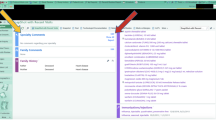Abstract
The clinical history and indication (CHI) provided with a radiological examination are critical components of a quality interpretation by the radiologist. A patient’s chronic conditions offer the context in which acute symptoms and findings can be interpreted more accurately. Seven pertinent (potentially diagnosis altering) chronic conditions, which are fairly prevalent at our institution, were selected. We analyze if and how in 140 CHIs there was mention of a patient’s previously reported chronic condition and if and how the condition was subsequently described in the radiology report using a four-item scheme (Mention/Specialization, Generalization, Common comorbidity, No mention). In 40.7 % of CHIs, the condition was rated Mention/Specialization. Therefore, we reject our first hypothesis that the CHI is a reliable source for obtaining pertinent chronic conditions (≥90.0 %). Non-oncological conditions were significantly more likely rated No mention in the CHI than oncological conditions (58.7 versus 8.3 %, P < 0.0001). Stat cases were significantly more frequently No mention than non-stat cases (60.0 versus 31.3 %, P = 0.0134). We accept our second hypothesis that the condition’s rating in the CHI is significantly correlated with its rating of the final radiology report (χ 2 test, P < 0.00001). Our study demonstrates an alarming lack of communication of pertinent medical information to the radiologist, which may negatively impact interpretation quality. Presenting automatically aggregated patient information to the radiologist may be a potential avenue for improving interpretation and adding value of the radiology department to the care chain.
Similar content being viewed by others
References
Bidgood WD and Horii SC: “Introduction to the ACR-NEMA DICOM Standard,” Radiographics, vol. 12, no. May, pp. 345–355, 1992
Borgstede JP: “Radiology: commodity or specialty,” Radiology vol. 247, no. 3, pp. 613–616, 2008
Boland GW: “Teleradiology for auction: the radiologist commoditized and how to prevent it,” J Am Coll Radiol, vol. 6, no. 3, pp. 137–138, 2009
Abramson RG, Berger PE and Brant-Zawadzki MN: “Accountable care organizations and radiology: threat or opportunity?,” J Am Coll Radiol vol. 9, no. 12, pp. 900–6, Dec. 2012
Lexa FJ and Berlin JW: “Accountable care organizations for neuroradiologists: threats and opportunities,” Neuroimaging Clin N Am., vol. 22, no. 3, pp. 437–41, Aug. 2012
Leslie A, Jones AJ and Goddard PR: “The influence of clinical information on the reporting of CT by radiologists,” Br J Radiol vol. 73, no. 874, pp. 1052–5, Oct. 2000
Cohen MD: “Accuracy of information on imaging requisitions: does it matter?,” J Am Coll Radiol vol. 4, no. 9, pp. 617–21, Sep. 2007
Chapman WW, Bridewell W, Hanbury P, Cooper GF, Buchanan BG: “A simple algorithm for identifying negated findings and diseases in discharge summaries,” J Biomed Inform vol. 34, no. 5, pp. 301–10, 2001
Aronson AR and Lang FM: “An overview of MetaMap: historical perspective and recent advances,” J Am Med Inform Assoc vol. 17, no. 3, pp. 229–236, 2010
Loy CT and Irwig L: “Accuracy of Diagnostic Tests Read With and Without Clinical Information-A Systematic Review,” JAMA vol. 292, no. 13, pp. 1602–1609, 2004
Gunderman RB, Phillips MD and Cohen MD: “Improving clinical histories on radiology requisitions.,” Acad Radiol, vol. 8, no. 4, pp. 299–303, Apr. 2001
Cohen MD, Curtin S and Lee R: “Evaluation of the quality of radiology requisitions for intensive care unit patients,” Acad Radiol, vol. 13, no. 2, pp. 236–40, Feb. 2006
Schneider E, Franz W, Spitznagel R, Bascom DA and Obuchowski NA: “Effect of Computerized Physician Order Entry on Radiologic Examination Order Indication Quality,” Arch Intern Med vol. 171, no. 11, pp. 1036–1037, 2011
Boonn WW and Langlotz CP: “Radiologist use of and perceived need for patient data access.,” J Digit Imaging, vol. 22, no. 4, pp. 357–62, Aug. 2009
Alkasab TK, Alkasab JR, Abujudeh HH: “Effects of a computerized provider order entry system on clinical histories provided in emergency department radiology requisitions.,” J Am Coll Radiol vol. 6, no. 3, pp. 194–200, Mar. 2009
Travis AR, Sevenster M, Qian Y, Mankovich G, Buurman J, Chang PJ: “Enhancing provided patient clinical information by automated review of prior radiology reports using the Clinical Context Indicator (CCI): a NLP based data extraction and presentation PACS-integrated tool,” in RSNA Annu Symp Proc., Dec. 2013
Author information
Authors and Affiliations
Corresponding author
Rights and permissions
About this article
Cite this article
Obara, P., Sevenster, M., Travis, A. et al. Evaluating the Referring Physician’s Clinical History and Indication as a Means for Communicating Chronic Conditions That Are Pertinent at the Point of Radiologic Interpretation. J Digit Imaging 28, 272–282 (2015). https://doi.org/10.1007/s10278-014-9751-7
Published:
Issue Date:
DOI: https://doi.org/10.1007/s10278-014-9751-7




